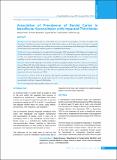Please use this identifier to cite or link to this item:
https://hdl.handle.net/20.500.14356/1098Full metadata record
| DC Field | Value | Language |
|---|---|---|
| dc.contributor.author | Kunwar, Deepa | - |
| dc.contributor.author | Koirala, Ujjwal | - |
| dc.contributor.author | Manandhar, Archana | - |
| dc.contributor.author | Subedi, Sushil | - |
| dc.contributor.author | Gurung, Nisha | - |
| dc.date.accessioned | 2023-04-24T05:33:54Z | - |
| dc.date.available | 2023-04-24T05:33:54Z | - |
| dc.date.issued | 2021 | - |
| dc.identifier.citation | KunwarD., KoiralaU., ManandharA., SubediS., & GurungN. (2021). Association of Prevalence of Dental Caries in Mandibular Second Molar with Impacted Third Molar. Journal of Nepal Health Research Council, 19(2), 259-263. https://doi.org/10.33314/jnhrc.v19i2.3310 | en_US |
| dc.identifier.issn | Print ISSN: 1727-5482; Online ISSN: 1999-6217 | - |
| dc.identifier.uri | http://103.69.126.140:8080/handle/20.500.14356/1098 | - |
| dc.description | Original Article | en_US |
| dc.description.abstract | Abstract Background: An impacted tooth is a tooth which does not reach the occlusal plane even after two-thirds root formation. Conditions associated with impacted teeth include trismus, cystic lesions, and cervical caries of second molars. The objective of this study was to evaluate the occurrence of carious lesions in the distal aspect of the mandibular second molar and its association with the presence of mandibular third molars. Methods: A cross-sectional study was conducted from September 2018 to September 2020. Approval was taken from the Institutional Review Committee with reference number 90/77/78. Orthopantomograms of patients aged 18 years or older were studied. Information on age, gender, mandibular second and third molars were recorded. Convenient sampling was done. Statistical analysis was done using Statistical Package for Social Sciences version 21. Results: A total of 626 radiographs were studied of which mesioangular impaction (35.3%) was the most prominent type and followed by horizontal impaction, causing distal caries in second molars. The age group between 20-40 years and female gender had the higher prevalence of distal caries in second molar teeth. There was a significant correlation between gender and cavity existence (p=0.00), between impaction and existence of decay (p=0.00), and depth of impaction with cavity formation (p=0.004). Conclusions: A total of 31.8% of the patients with impacted mandibular third molars had distal cervical caries in second molars. Mesioangular type, female gender, type A were the prominent factors associated with distal caries in second molar teeth due to impacted third molars. Keywords: Impacted tooth; mandible; molars; root caries | en_US |
| dc.language.iso | en | en_US |
| dc.publisher | Nepal Health Research Council | en_US |
| dc.relation.ispartofseries | Apr-June, 2021;3310 | - |
| dc.subject | Impacted tooth | en_US |
| dc.subject | mandible | en_US |
| dc.subject | molars | en_US |
| dc.subject | root caries | en_US |
| dc.title | Association of Prevalence of Dental Caries in Mandibular Second Molar with Impacted Third Molar | en_US |
| dc.type | Journal Article | en_US |
| local.journal.category | Original Article | - |
| Appears in Collections: | Vol. 19 No. 2 (2021): Vol 19 No 2 Issue 51 Apr-Jun 2021 | |
Files in This Item:
| File | Description | Size | Format | |
|---|---|---|---|---|
| 3310-Manuscript-23760-1-10-20210907.pdf | Fulltext Download | 204.63 kB | Adobe PDF |  View/Open |
Items in DSpace are protected by copyright, with all rights reserved, unless otherwise indicated.
